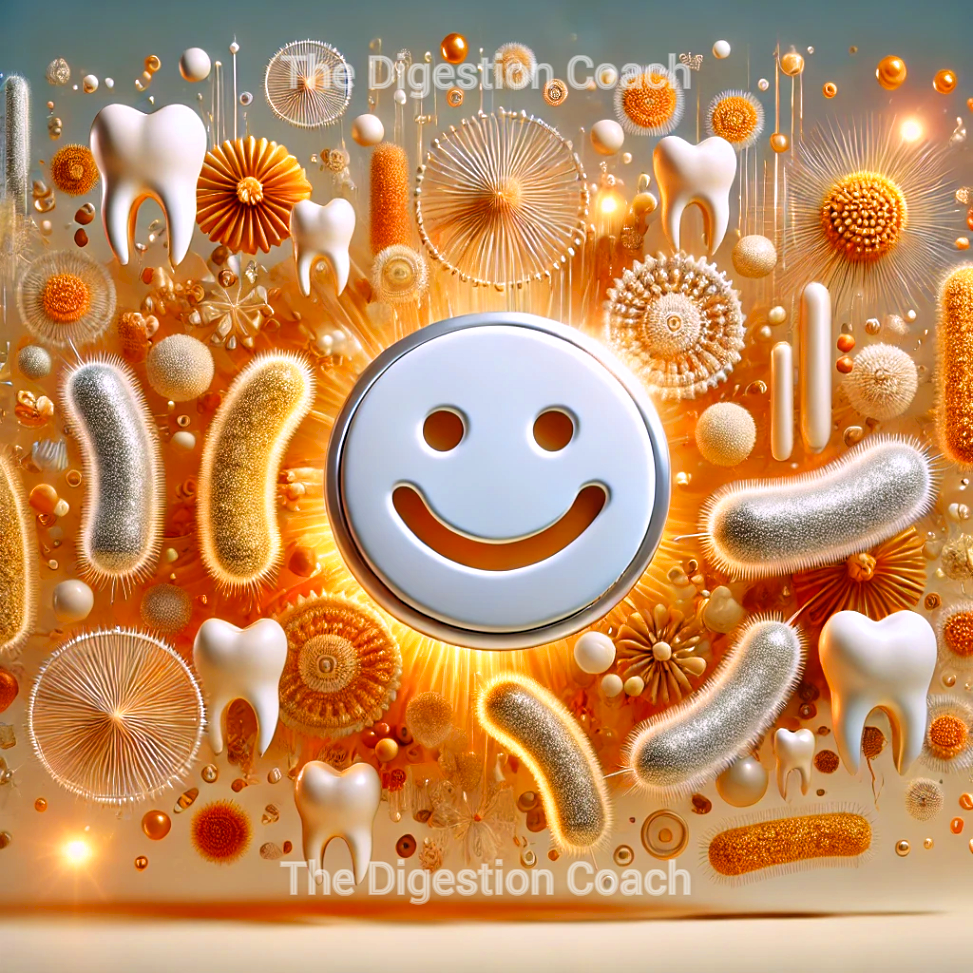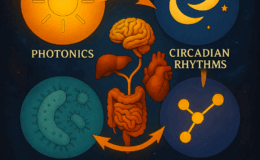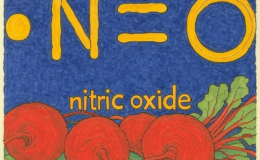Oral Microbiome Support Guide Table of Contents
- Key Terms and Definitions
- Key Beneficial Bacteria in the Oral Microbiome
- Harmful Strict Anaerobic Bacteria in the Mouth
- Strategies for Oral Microbiome Support
- Daily Oral Microbiome Support Protocol
- Conclusion
- FAQ
The oral microbiome is a dynamic ecosystem of beneficial, commensal, and pathogenic bacteria that influence oral and systemic health. As a gut health specialist, it’s essential I help my patients to maintain a positive balance between beneficial and harmful microbes to promote an environment that prevents conditions such as periodontitis, halitosis, cavities, and systemic inflammation. Oral microbiome support focuses on strategies to nurture beneficial bacteria while suppressing harmful anaerobes through targeted interventions.
Key Terms and Definitions
- Commensal Bacteria: Microorganisms that naturally reside in the body without causing harm and may provide benefits by outcompeting pathogens. They are essential for maintaining balance.
- Aerobic Bacteria: Bacteria that require oxygen to survive and grow. These are often the ‘good guys’ in your mouth, helping to keep the environment oxygenated.
- Strict Anaerobic Bacteria: Bacteria that thrive in oxygen-free environments, often linked to periodontal diseases. Examples include Porphyromonas gingivalis and Prevotella species.
- Facultative Anaerobe Bacteria: These bacteria can adapt to aerobic and anaerobic conditions, making them versatile in the oral cavity.
- Biofilm: A complex community of bacteria encased in a protective matrix, adhering to surfaces like teeth, contributing to dental plaque.
- Halitosis: Chronic bad breath, which is frequently a result of the activity of anaerobic bacteria producing volatile sulfur compounds.
- Bacteriocins: Antimicrobial peptides produced by beneficial bacteria, like Streptococcus salivarius, to inhibit harmful bacteria.
- Quorum Sensing: A bacterial communication mechanism that controls gene expression and biofilm development based on bacterial density.
- Hydroxyapatite Toothpaste: An alternative to fluoride toothpaste, hydroxyapatite toothpaste helps remineralize tooth enamel by depositing hydroxyapatite, which is naturally found in teeth.
Key Beneficial Bacteria in the Oral Microbiome
These bacteria contribute to a healthy oral environment by preventing harmful microbes, modulating pH, and supporting immune function. Oral microbiome support promotes their growth for optimal health.
Aerobic & Facultatively Anaerobic Beneficial Bacteria
- Neisseria species – Nitrate-reducing bacteria that support nitric oxide (NO) production and vascular health.
- Haemophilus species – Contribute to biofilm balance and microbial homeostasis.
- Streptococcus mitis, S. sanguinis, and S. salivarius – Are early colonizers that produce hydrogen peroxide to inhibit pathogens.
- Rothia species – Assist in carbohydrate metabolism and maintain biofilm integrity.
- Corynebacterium species – Help structure biofilms to support beneficial species.
- Veillonella species – Convert lactate into less acidic byproducts, reducing acidity and cavity formation.
Harmful Strict Anaerobic Bacteria in the Mouth
These bacteria thrive in low-oxygen environments and contribute to periodontitis, halitosis, and oral infections. Oral microbiome support helps suppress these pathogens through oxygenation, pH balance, and probiotics.
- Porphyromonas gingivalis – A key driver of gum disease and systemic inflammation.
- Prevotella species – Linked to gingivitis and periodontal infections.
- Fusobacterium nucleatum – Acts as a “bridge” between early and late colonizers in pathogenic biofilms.
- Treponema denticola – A spirochete that invades tissue and contributes to deep periodontal pockets.
- Tannerella forsythia – Works synergistically with P. gingivalis to degrade gum tissue.
- Dialister species – Associated with periodontitis and halitosis.
- Eubacterium species – Some strains contribute to root infections.
- Parvimonas micra – Implicated in deep periodontal infections.
- Campylobacter rectus – Found in aggressive periodontitis cases.
Strategies for Oral Microbiome Support
A. Increase Oxygen Availability
- Improve Oral Hygiene: Brushing, flossing, and using interdental brushes remove biofilms that harbor anaerobic bacteria.
- Encourage Saliva Flow: Stay hydrated, chew fibrous foods, and consider chewing xylitol gum.
- Breathe Through the Nose: Nasal breathing increases nitric oxide (NO) levels, suppressing anaerobic pathogens.
B. Optimize Nutrients to Selectively Feed Beneficial Bacteria
- Nitrate-Rich Foods: Leafy greens (spinach, arugula, beets) fuel Neisseria and Rothia, enhancing NO production.
- Polyphenol-Rich Foods: Green tea, berries, and dark chocolate support beneficial bacteria and inhibit harmful microbes.
- Reduce Fermentable Protein Residue: Limit protein-rich food residue in the mouth, as anaerobes metabolize amino acids into harmful byproducts.
C. Maintain a Slightly Alkaline Oral pH
- Rinse with Baking Soda (1% Solution): Neutralizes acid and prevents anaerobic overgrowth.
- Use Hydroxyapatite or xylitol-based toothpaste, which helps remineralize teeth while reducing biofilm adherence.
- Chew Xylitol Gum or Lozenges: Raises pH and inhibits acid-producing bacteria.
D. Introduce Beneficial Oral Probiotics
- Streptococcus salivarius BLIS K12 & M18: Produce bacteriocins that inhibit Porphyromonas, Prevotella, and Fusobacterium.
- Lactobacillus reuteri: Supports oral and gut health by reducing inflammation and competing with pathogens.
- How to Use: Take lozenges, chewable tablets, or fermented foods rich in these strains.
E. Disrupt Quorum Sensing & Biofilm Formation
- Hydrogen Peroxide Rinses (1-3% H₂O₂): Generates oxygen to break down anaerobic biofilms.
- Essential Oils (Cinnamon, Clove, Tea Tree): Contain compounds that block bacterial communication.
- Garlic (Allicin) & Ginger: Disrupt quorum sensing and inhibit anaerobic bacteria. See also, Threonine-Rich Foods To Support Gut Health
F. Reduce Deep Periodontal Pockets & Plaque Retention
- Ultrasonic Scaling & Root Planing: Physically removes pathogenic biofilms.
- Interdental Flossing & Water Flossers: Prevents Fusobacterium-mediated plaque bridges.
G. Limit Overuse of Antimicrobial Mouthwashes
- Avoid Chlorhexidine Overuse: While effective against pathogens, it also kills beneficial bacteria.
- Use Herbal or Essential Oil-Based Rinses: Gentler on beneficial microbes while still disrupting pathogens.
H. Consider Ozone Therapy for Severe Cases
- Ozone (O₃) Treatments: Oxidizes bacterial membranes, selectively targeting strict anaerobes.
- Used in Dentistry: Effective for periodontal infections and root canals.
Daily Oral Microbiome Support Protocol
Morning Routine:
- Nasal Breathing for NO production.
- Brush with hydroxyapatite or Now Foods Xylowhite (tea tree oil and neem) toothpaste.
- Floss & use an interdental brush.
- Rinse with a mild solution of hydrogen peroxide or baking soda solution.
- Take oral probiotics (S. salivarius BLIS K12, M18, or L. reuteri).
Throughout the Day:
- Stay hydrated and chew xylitol gum after meals.
- Eat nitrate-rich foods (leafy greens) and polyphenol-rich foods (berries, green tea).
- Avoid excessive sugars and fermentable proteins.
Evening Routine:
- Brush with hydroxyapatite toothpaste.
- Floss & use a water flosser.
- Rinse with a mild essential oil-based mouthwash.
- Consider ozone or herbal rinses for persistent periodontal issues.
Conclusion
A digestive coaching maxim is that a balanced oral microbiome support strategy is essential for preventing dental disease, supporting immune function, and influencing systemic health. It could also hold the key to promoting healthy aging. You can foster a thriving oral ecosystem by oxygenating the mouth, optimizing nutrients, promoting beneficial bacteria, and disrupting harmful anaerobes.
FAQ
How long does it take to rebalance the oral microbiome? With proper interventions, significant changes can be seen in 4-8 weeks.
Can probiotics replace mouthwash? They complement each other; use gentle antimicrobial rinses while introducing probiotics.
What’s the best diet for oral microbiome health? A diet rich in nitrate-containing vegetables, polyphenols, and prebiotic fibers, such as lentils, supports beneficial bacteria.
Is fluoride necessary for a healthy mouth? Hydroxyapatite is an alternative that remineralizes teeth without fluoride.
Does mouth breathing harm the oral microbiome? Yes, it reduces nitric oxide levels, dries out saliva, and promotes anaerobic bacterial overgrowth.
COMPLEMENTARY 15-MINUTE CALL
Take your first step toward a renewed sense of well-being. Call today to arrange a complimentary 15-minute consultation.
Let’s discern whether my approach aligns with your needs.
I look forward to connecting with you at 714-639-4360.
Pantothenate: Microbiome-Mediated Regulation and Strategies to Combat Sugar Cravings










